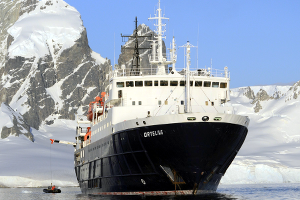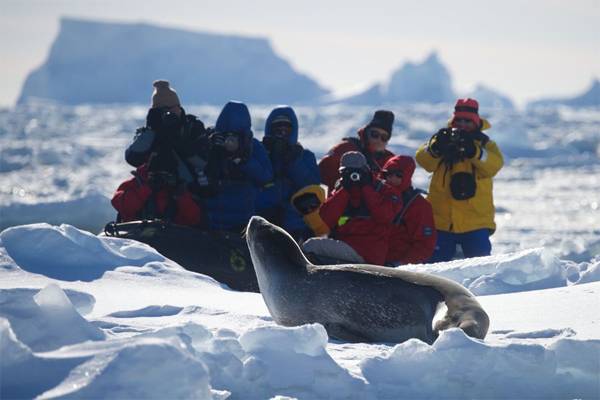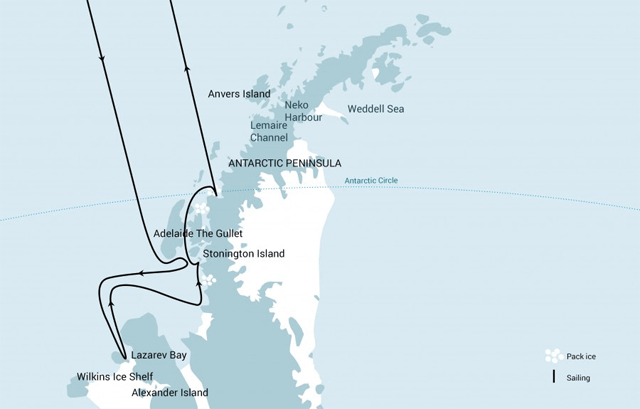HIGHLIGHTS
Beyond
the Polar Circle: Wilkins Ice Shelf
This
voyage is a true expedition, exploring the rarely visited region of the
Bellingshausen Sea, Marguerite Bay, and Alexander Island. We explore
many of the places discovered by Adrien de Gerlache on his Belgian
Antarctic Expedition (1897 – 1899) aboard the Belgica. This
voyage leaves Ushuaia and heads straight beyond Antarctic Circle, where
we aim to spend the rest of the trip. The variety of landings and
wilderness in this region are rivalled by few other places on Earth.
We
will see Antarctic ice shelves, land on islands where few people have
set foot, and enjoy this awe-inspiring area far from the beaten track
of regular Antarctic cruises. We may also see a range of exotic
wildlife, including humpback and minke whales, orcas, and a variety of
seals: leopard, elephant, crabeater, Weddell, Antarctic fur, and maybe
even a Ross seal. Gentoo and Adélie penguins, skuas, terns,
and giant petrels are just some of the bird species we may see as well.
Astronomy
& aurora australis:
Spring
2025 marks the best chance to see the rare aurora australis, also known
as the southern lights. Unlike the northern lights, the southern lights
travel over no cities or villages and are only rarely seen from land.
The sun’s 11-year cycle of activity peaks around 2025, making
for more active auroras that are best seen around the equinoxes. We
will maximize our chances of seeing the elusive and enchanting southern
auroras by traveling below the Antarctic Circle when there is little
moonlight in the sky. We will also have the chance to see many Southern
Hemisphere stars and celestial objects, including the Southern Cross
and Magellanic Clouds.
Dr.
Tyler Nordgren will lead our night sky viewing activity on deck when
the weather and auroras are favorable, speaking about the southern sky
and its auroras. Nordgren is a professor of astronomy and physics at
the University of Redlands as well as a former member of the Board for
the International Dark Sky Association.
Dr.
Julie Rathbun will continue this trip’s theme of polar and
astronomical exploration, leading discussions about how Antarctica is
used as a site to study Europa, one of Jupiter’s moons. A
senior scientist with the Planetary Science Institute, she is part of
NASA's Europa Clipper spacecraft mission, which launches in October
2024 to investigate the liquid ocean beneath Europa’s icy
surface.
DATES / RATES
Rates are listed per person
|
| Start Date | End Date | From EUR | From USD |
|---|
Rates are listed per person
|
| Start Date | End Date | From EUR | From USD |
|---|
ITINERARY
Day
1: End of the world, start of a journey
Your
voyage begins where the world drops off. Ushuaia, Argentina, reputed to
be the southernmost city on the planet, is located on the far southern
tip of South America. Starting in the afternoon, you embark from this
small resort town on Tierra del Fuego, nicknamed “The End of
the World,” and sail the mountain-fringed Beagle Channel for
the remainder of the evening.
Day
2 – 3: Path of the polar explorers
Over
the next two days on the Drake Passage, you enjoy some of the same
experiences encountered by the great polar explorers who first charted
these regions: cool salt breezes, rolling seas, maybe even a fin whale
spouting up sea spray. After passing the Antarctic Convergence
– Antarctica’s natural boundary, formed when
north-flowing cold waters collide with warmer sub-Antarctic seas
– you are in the circum-Antarctic upwelling zone.
Not
only does the marine life change, the avian life changes too. Wandering
albatrosses, grey-headed albatrosses, black-browed albatrosses,
light-mantled sooty albatrosses, cape pigeons, southern fulmars,
Wilson’s storm petrels, blue petrels, and Antarctic petrels
are a few of the birds you might see.
Day
4: Through the Pendleton Strait
You
arrive at the Antarctic Peninsula near the Antarctic Circle in the
afternoon. If sea ice allows it, you can then continue through
Pendleton Strait and attempt a landing at the rarely visited southern
tip of Renaud Island. Here you have the opportunity to see the first
Adélie penguins of the trip as well as enjoy spectacular
views of the icebergs in this surreal, snow-swept environment.
In
the afternoon we sail to the Fish Islands and encounter one of the
southernmost Adélie penguin and blue-eyed shag colonies in
the Antarctic Peninsula.
Spending
the night in the area of Crystal Sound the scenery will leave you
staying up until the small hours, there is a chance to see Orca,
Humpback and Minke Whale in this area.
Day
5: Detaille Island and The Gullet
Detaille
Island – You may make a landing at an abandoned British
research station here, taking in the island’s lofty position
and imposing glaciers scenery.
We
then sail through The Gullet, one of the most impressive narrow
channels in Antarctic, with towering mountains either side, birds
following the ship and playful penguins and seals frolicking in the
water as we sail through this very special part of the journey. If ice
conditions allow we will also carry out a landing or cruise in the
afternoon.
Day
6: Porquoi Pas and Horseshoe Islands
Discovered
and charted by the famous explorer Charcot, Pourquoi Pas offers a
pleasant landing on a rocky beach against the backdrop of the mighty
Moider Glacier. A gentle walk from the landing site provides an
impressive view, while Antarctic furs seals relaxing behind the beach
are a nice addition to the wildlife we’ve encountered on this
voyage.
After
lunch we head toward Horseshoe Island, named for its distinctive shape.
An abandoned research station provides an insight into the early days
of scientific research, and original artifacts show how different life
was in those pioneering days. The hut is set among some of the most
beautiful scenery in Antarctica, with views over the mountains and snow
of Pourquoi Pas Island as well as Horseshoe Island’s mountain
range. This is a photographic landing in many senses. Two old wooden
boats even remain at the landing site as if waiting for their final
launch.
Day
7 - 10: George IV and Wilkins Ice Shelf
Provided
ice and weather conditions allow, you next head toward
Antarctica’s ice shelves (the George IV and Wilkins). Here we
hope to show you the scale of these vast cliffs and expanses of ice
that will dwarf us and our ship. A range of Antarctic wildlife like
humpback whales, fur seals, Adélie penguins, and maybe even
one or more Ross’ seals may appear.
Day
11: Jenny and Leonie Islands
Jenny
Island will give another aspect to your Antarctic experience, offering
raised beaches, hanging glaciers, and moss carpets. The island is also
popular with wildlife: Terns, skuas, elephant seals, leopard seals, and
Adélie penguins are all regular visitors.
A
landing at Leonie Island will take your breath away. There is also the
possibility to take a hike to the peak of the island, giving you a
dramatic panorama of Marguerite Bay and Adelaide Island.
Day
12: Lagoon and Mikkelsen Islands
Lagoon
island is the most northern island of the Leonie Islands group, also
discovered and charted by Jean-Baptiste Charcot. This low laying island
will provide a stark contrast to the previous days with its gently
sloped beaches and flat areas to explore. The wildlife here will varies
depending on snow cover. If there is little snow the ground is almost
desert-like in appearance.
The
Mikkelsen Islands offer a spectacular Zodiac cruise where we hope to
encounter up to five Antarctic seal species. We may also see some
beautiful birdlife, such as giant petrels and Adélie
penguins.
Day
13 - 15: Familiar seas, familiar friends
Your
return voyage is far from lonely. While crossing the Drake,
you’re again greeted by the vast array of seabirds remembered
from the passage south. But they seem a little more familiar to you
now, and you to them.
Day
16: There and back again
Every
adventure, no matter how grand, must eventually come to an end.
It’s now time to disembark in Ushuaia, but with memories that
will accompany you wherever your next adventure lies.
Ortelius (Expedition, 108-guests)
Ortelius offers a comfortable hotel standard, with a u-shaped, a bar and a lecture room. Our voyages are primarily developed to offer our passengers a quality exploratory wildlife program, trying to spend as much time ashore as possible. As the number of passengers is limited to approximately 116 on the Ortelius, flexibility assures maximum wildlife opportunities. Ortelius carries 10 zodiacs
 (Click image to view Ship details)
(Click image to view Ship details)
WHAT'S INCLUDED
- Voyage
aboard the indicated vessel as indicated in the itinerary
- All
meals throughout the voyage aboard the ship including snacks, coffee
and tea.
- All
shore excursions and activities throughout the voyage by Zodiac.
- Program
of lectures by noted naturalists and leadership by experienced
expedition staff.
- Free
use of rubber boots and snowshoes.
- Luggage
transfer from pick-up point to the vessel on the day of embarkation, in
Ushuaia.
- Pre-scheduled
group transfer from the vessel to the airport in Ushuaia (directly
after disembarkation).
- All
miscellaneous service taxes and port charges throughout the programme.
- Comprehensive
pre-departure material.
Excluded
from this voyage
- Any
airfare, whether on scheduled or charter flights.
- Pre-
and post- land arrangements.
- Passport
and visa expenses.
- Government
arrival and departure taxes.
- Meals
ashore.
- Baggage,
cancellation and personal insurance (which is strongly recommended).
- Excess
baggage charges and all items of a personal nature such as laundry,
bar, beverage charges and telecommunication charges.
- The
customary gratuity at the end of the voyages for stewards and other
service personnel aboard (guidelines will be provided).
ADVENTURE OPTIONS - Zodiac Cruising
- Shore Programs







